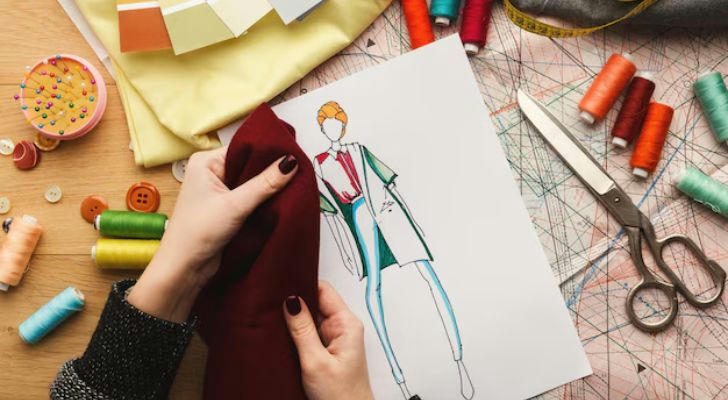How to Study Fashion Design and Clothing Making Courses at Home
Fashion design and clothing making have always been considered elite skills, traditionally taught in schools and universities with expensive tuition fees and rigorous schedules. But what if you could learn all of this from the comfort of your home, at your own pace, and without the pressure of a classroom setting? With the rise of online resources, tutorials, and self-paced courses, studying fashion design and clothing making at home has never been more accessible.

1. Start with the Basics: Fashion Design Fundamentals
Before you dive into sewing and making clothes, it's important to understand the principles of fashion design. Fashion design isn’t just about making things look good – it's about creating functional, aesthetically pleasing garments that communicate style and personality.
Here’s a quick breakdown of the basics you should start learning:
• Fashion Sketching: Fashion design begins with sketches. It’s where your ideas take form.There are many online tutorials that teach you how to draw fashion sketches, from basic human body proportions to illustrating detailed garments.
• Color Theory: Understanding color and how it works with fabrics is crucial. Learn about the different color schemes, fabric textures, and how to combine them to create visually stunning designs.
• Textiles: Different fabrics have unique properties – from silk to denim to wool. Knowing the characteristics of these materials helps designers create the right garment for the right occasion.
• Fashion History: Learning about the history of fashion helps you understand trends, patterns, and the evolution of styles. It also helps to inspire your own work, whether you’re designing for today or creating something inspired by a past era.
2. Learn Sewing Skills and Techniques
Fashion design is only half the equation; the ability to turn your designs into real, wearable garments is where the fun begins. Fortunately, sewing is a skill that can be learned at home, even by beginners. There are plenty of online resources – from YouTube tutorials to free blogs – that cover everything from basic hand stitching to advanced techniques.
Here’s what you need to start learning:
• Hand Sewing: Before you start working with a sewing machine, it's useful to learn the basics of hand sewing. Mastering simple stitches like the running stitch, backstitch, and whipstitch will help you repair garments and add finishing touches to your creations.
• Machine Sewing: A sewing machine is your best friend when it comes to making clothes. You can find various tutorials on how to use a sewing machine – from threading the needle to mastering basic stitches like straight stitch, zigzag stitch, and buttonhole stitch.
• Pattern Making: Learning how to create and use patterns is key to bringing your designs to life. You can either make your own patterns or purchase pre-made ones. Many fashion designers prefer to make custom patterns, which allows for more creative control over the fit and structure of their designs.
• Fabric Cutting: Proper fabric cutting is essential for ensuring your garments turn out as you envisioned. Learn how to lay out your fabric, use pattern weights, and cut accurately.

3. Use Online Resources and Courses
One of the best ways to learn fashion design and clothing making at home is by using online resources. Whether you prefer video tutorials, online courses, or reading books, there’s a wealth of content available to help you get started.
• YouTube: There’s an endless supply of free content available on YouTube that covers every aspect of fashion design, from sketching to sewing. Channels like “Made to Sew” and “Fashion Sewing Blog” offer clear and easy-to-follow lessons that you can watch at your own pace.
• Online Learning Platforms: Websites like Skillshare, Udemy, and Coursera offer paid courses on fashion design and sewing. These courses usually have structured lessons, assignments, and feedback from experts to help you build your skills systematically.
• Fashion Design Blogs: Many fashion designers and sewing enthusiasts share their tips, tutorials, and advice through blogs. Sites like “The Sewing Loft” and “Sewing.org” offer free patterns, sewing tips, and design inspiration.
• Fashion Books: Books like “Fashion Design Course” by Steven Faerm and “The Fashion Sketchbook” by Bina Abling are great resources for learning the theory behind design and the practical skills of making clothes.
4. Practice, Practice, Practice
Like any skill, fashion design and sewing require practice. Start small and work your way up as you gain confidence. Begin by creating simple projects like skirts, tops, or basic accessories before trying your hand at more complex designs.
It’s a great idea to practice by reworking or upcycling old clothes. For example, you can take an old t-shirt and transform it into a stylish tank top or even cut it up and use the fabric to make a new garment. This will help you hone your skills without needing to invest in new materials right away.
Also, experiment with different fabrics and patterns. Each fabric has its own quirks, and learning how different textiles behave is a crucial part of becoming proficient in clothing making. Start with cotton, and as you build confidence, explore other fabrics like jersey, silk, or leather.
5. Join Fashion Design Communities
Learning fashion design and clothing making at home doesn’t mean you have to do it alone. There are plenty of online communities where you can share your work, ask for feedback, and get inspired by others.
• Social Media: Instagram and Pinterest are full of fashion designers and enthusiasts sharing their latest projects, sketches, and creations. Following other designers can help spark your creativity and keep you motivated.
• Online Forums: Websites like Reddit have active fashion design and sewing communities where people share their experiences, challenges, and successes. Joining these communities can help you learn from others and stay inspired.
• Local Sewing Groups: If you prefer face-to-face interaction, look for local sewing or design groups. Many cities have meetups where people can sew together and learn from one another.

Set Goals and Stay Committed
To make progress in fashion design and clothing making, set achievable goals. Whether it’s completing a certain number of sewing projects each month or mastering a new technique, having clear goals will keep you focused.
Remember, fashion design is a creative process, so don’t rush it. Take your time to experiment, make mistakes, and learn from them. The more time and energy you invest in practicing and expanding your skills, the closer you’ll get to achieving your fashion goals.
